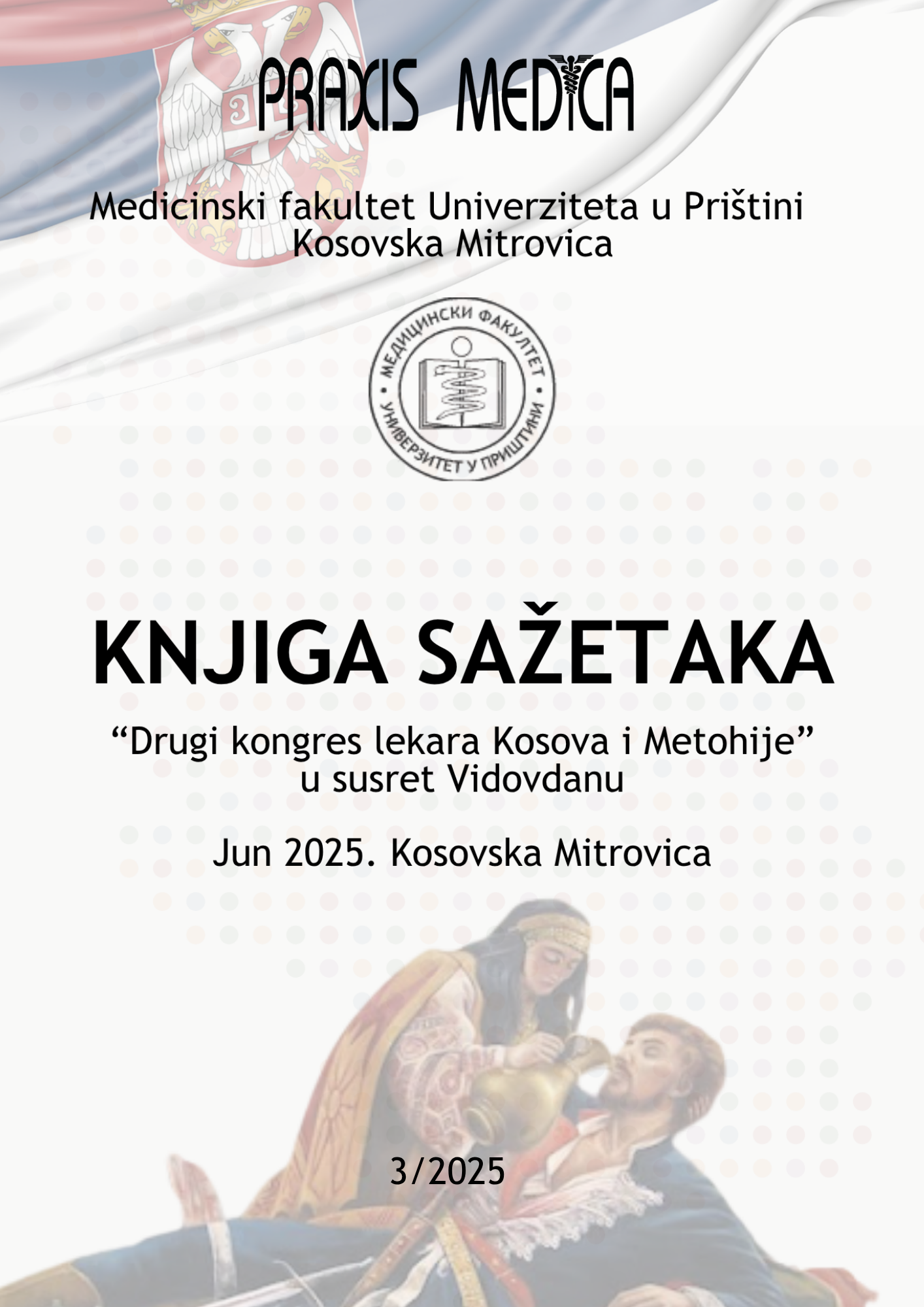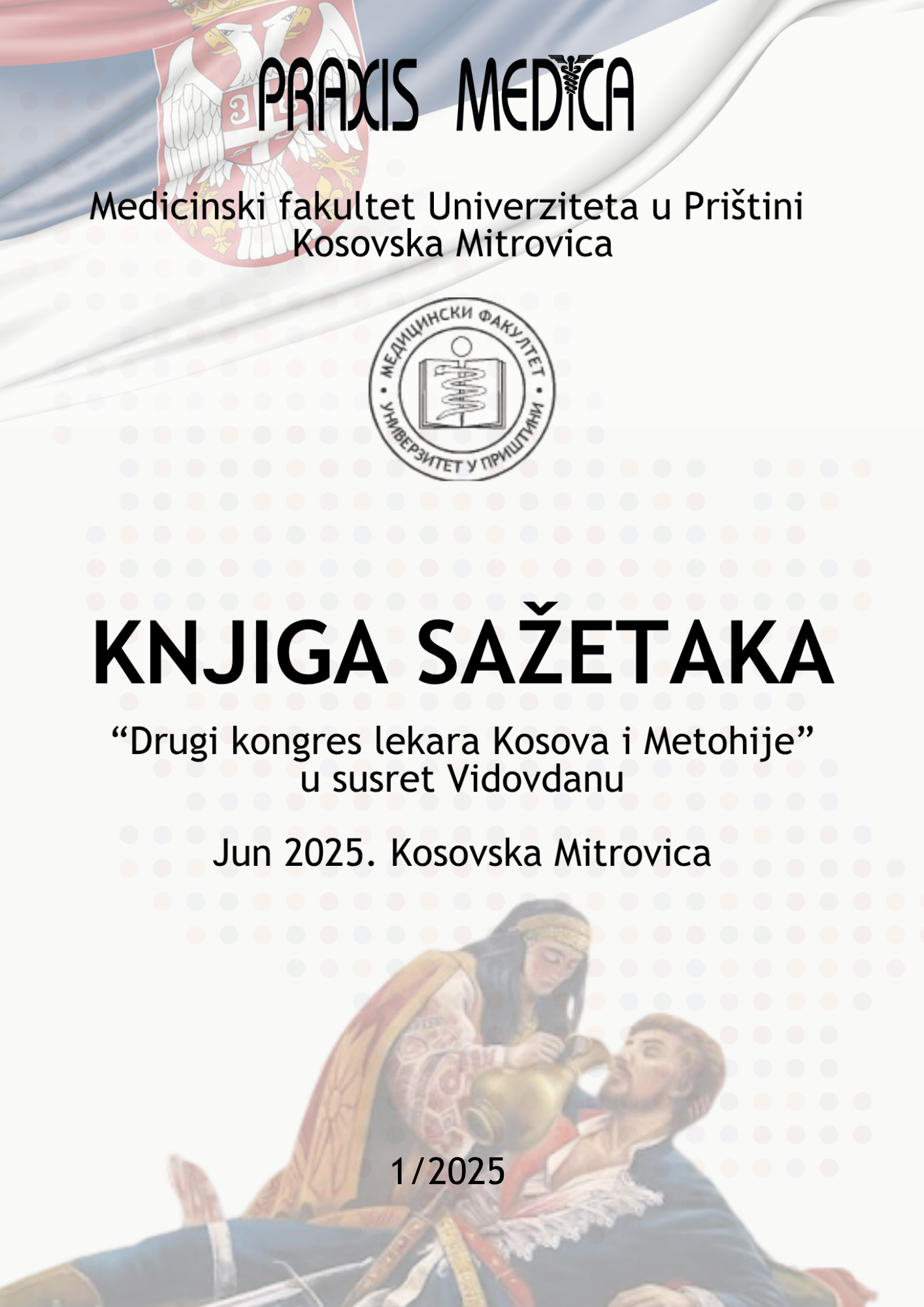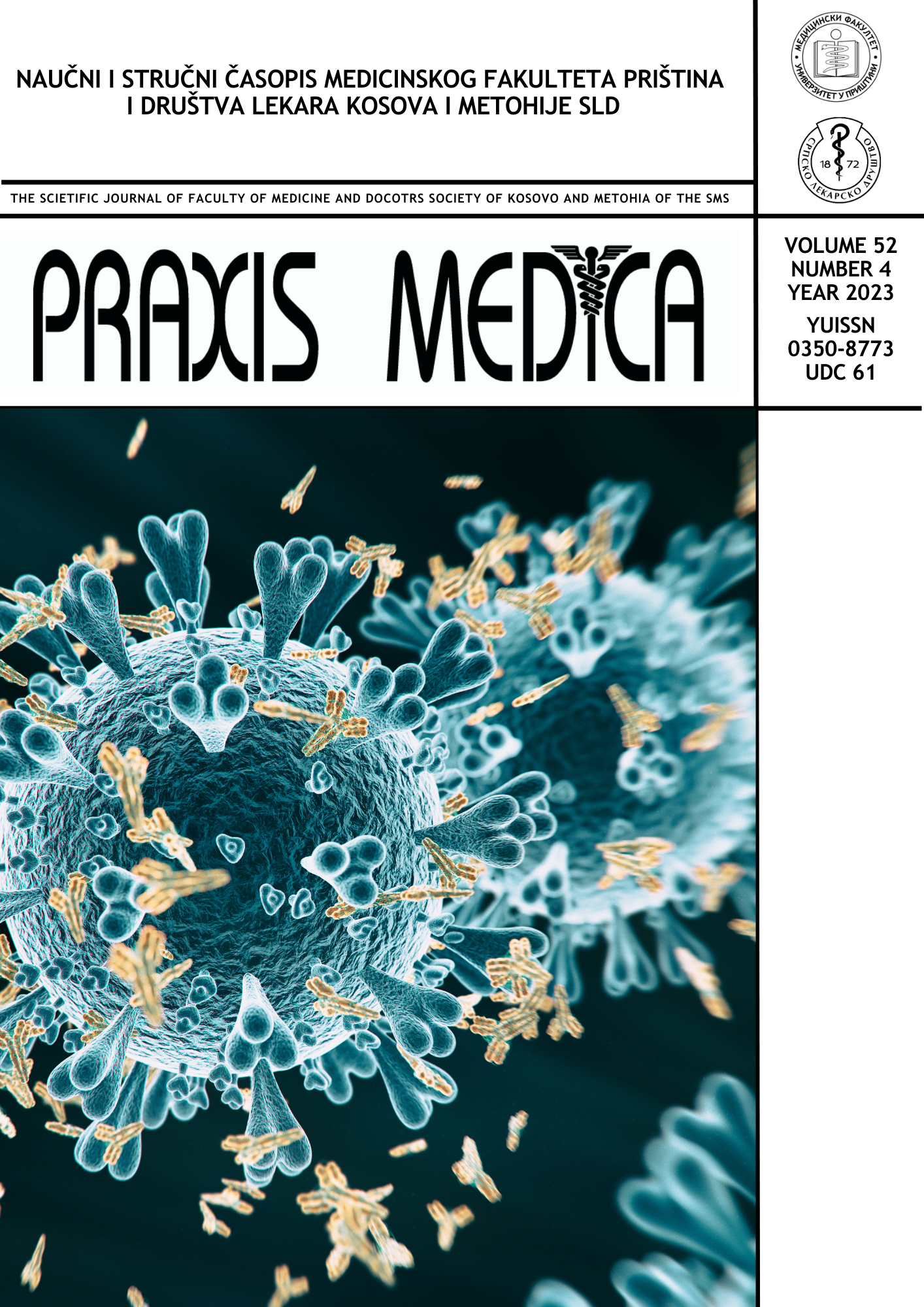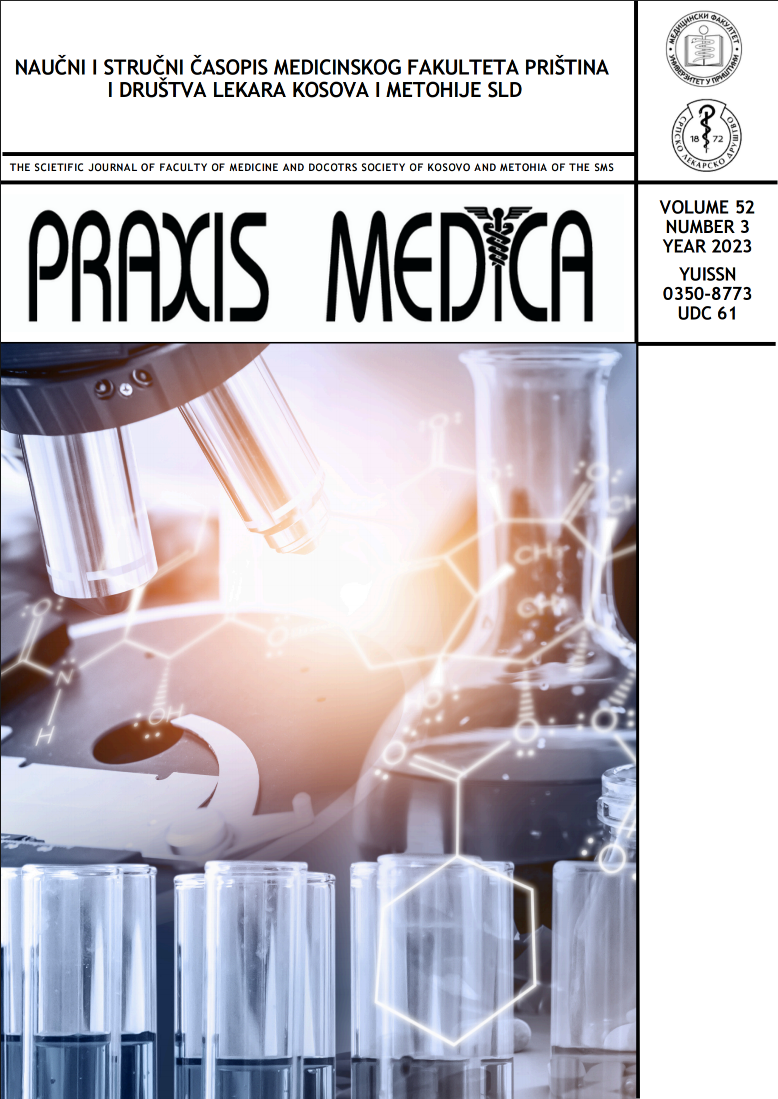Current issue

Volume 53, Issue 4, 2025
Online ISSN: 2560-3310
ISSN: 0350-8773
Volume 53 , Issue 4, (2025)
Published: 30.06.2025.
Open Access
All issues
Contents
01.12.2006.
Case Reports
GOUT - DIAGNOSTIC DIAGNOSTIC AND THERAPY THERAPY - case raport
Gout is a metabolic arthropathy caused by abnormal deposition of crystal histological they are urats (salts) of mononatrium in the joints and periatricular connective tissue. In 70% cases, decreased renal function in urats’excretion is responsible for hyperuricaemya. The other causes are mostly metabolic: increased (take in) of food wich contains mostly meat (purins) and increased synthesis of purin due to defective enzyme system (i.e. Lesch-Nyhan Sy)
Z. Petković, M. Mirković
01.12.2006.
Professional reviews
THE ENDOCRINE FUNCTION OF ADIPOSE TISSUE AND ITS CLINICAL SIGNIFICANCE
Adipose tissue secretes bioactive peptides, termed 'adipokines', which act locally and distally through autocrine, paracrine and endocrine signals. Those signals influences the answers of other tissues and organs including hypothalamus, pancreas, liver, sceletal muscles, endotel an immune system. Increased production of most adipokines impacts on multiple functions such as appetite and energy balance, immunity, insulin sensitivity, angiogenesis, blood pressure, lipid metabolism and haemostasis, all of which are linked with cardiovascular disease. Leptin is a critical mediatorof energy balance that relays information regarding the depletion or accumulation of fat stores to the brain. Althoughmany of leptin's effects result rb from a direct action ofleptin on hypothalamic neurons, the functional leptin receptor(long-form or lep ) is also found on many tissues outside the central nervous system (CNS), including immune cells. Obese individuals seem to be resistantto the hypothalamic effects of leptin (maybe because of defective blood-brain barrier transport), the catabolic pathways designed to reduce appetite and increase energy expenditure are not activated and excess body weight is maintained). Adipokines like adiponectin and leptin, at least in physiological concentrations, are insulin sparing as they stimulate beta oxidation of fatty acids in skeletal muscle. The role of resistin is less understood. It is implicated in insulin resistance in rats, but probably not in humans. Adiponectin and resistin are adipocyte-derived polypeptide hormones playing a role in metabolic homeostasis. Their plasma levels are inversely (adiponectin) or directly (resistin) correlated to obesity (and in a patients with type 2 diabetes mellitus) and they have opposite effects on insulin sensitivity. Adipocytes secretes also adipsin, factor B and factor C. In-depth understanding of the pathophysiology and molecular actions of adipokines may, in the coming years, lead to effective therapeutic strategies
S. Leštarević, Z. Anðelković
01.12.2006.
Professional reviews
HORMON REGULATION OF SEBACEOUS SECRETION AND ITS IMPORTANCE IN PATOPHYSIOLOGY OF ACNE VULGARIS
Acne is a chronic inflammatory disease of the pilo sebaceous follicules. The sites involved are the seborrheic areas in sebaceous glands mainly face, upper chest, back and the shoulder areas. The usual types of acne occur puberty. Acne is rare in children and old age. Increase in the activity of sebaceous glands and occlusion of the pilosebaceous orifices are the main factors of acne pathogenesis. Androgens increase the activity of sebaceous gland in both sexes. The usual types of acne occur in some endocrine abnormality and disorders. We analyzed hormones control of the acne and its role in occurrence of acne
M. Relić, G. Reli, L. Dejanović
01.12.2006.
Professional reviews
SIGNIFICATION OF MAGNESIUM IN THERAPY OF CARDIOVASCULAR DISEASES
Cardiovascular diseases are one of the most significant social-medical problems. Having on mind their importance, the risk factors have been defined. Numerous clinical and epidemiological studies showed that deficit of magnesium in the human organism has a certain contribution in etiology, pathogenesis and evolution of cardiovascular diseases. RASKO, Rakovica's study of cardiovascular diseases, found out that these diseases are more frequent at the locations where
soft water with decreased content of magnesium is being used as drinking water. Magnesium is an integral part of about 300 enzyme systems in which catalyst's role have adenositriphospathase as Mg-ATP, a part of NaKATP-ase, exogenous and endogenous pumps for calcium, etc. A normal plasmatic concentration of magnesium is 0,8-1 mmol/l. Plasmatic level of magnesium is not directly correlated with actually content in an organism since 33% of plasmatic magnesium is connected with plasma's proteins and that's why hypoproteinemia can cause a false hypomagnesemia. The normal values of magnesemia don't exclude deficit of magnesium in an organism since PTH and calcitonin mobilize magnesium from the bones. Hypomegnesemia is caused by improper and irrational nutrition, hormone disturbances, and different conditions and diseases of an organism. Magnesium has vasodiletatoric, antianginosic, hypolipemic, antiagregatic effects. Mechanism of magnesium's effect is based on its physiological role in an organism, i.e. on correction of hypomagnesemia. In preventive and therapeutic purposes magnesium's compounds are used peroraly and parenteraly. With parenteral use the plasmatic concentrations of more than physiological 2,5-7,5 mEq/l can be attained in which case somnolentia can be appeared but not a coma nor depression of breathing. In prevention and therapy of cardiovascular diseases magnesium has a significant place in the largest number of cases as an adjuvant drug
B. Vučinić, R. Mitić, Z. Milovanović
01.12.2006.
Case Reports
PITYRIASIS LICHENOIDES ET PITYRIASIS LICHENOIDES ET VARIOLIFORMIS ARIOLIFORMIS ACUTA (PLEVA)
With this case report we want to introduce is one rare disease, which can be spontaneonsly treat, buth it has a rare return. We present a pacient with rare febrile ulcero-necrotic variant, a possible persistent variant of PLEVA. The disease has been reprted in 20-th young adult
L. Dejanović, M. Relić, J. Ivanović, N. Krstić
01.12.2006.
Science Reports
METFORMIN-ALTERNATIVE DRUG FOR MEDICATION INSULINE RESITENCE AMONG THE INVOLVED PEOPLES WITH DIABETES TYPE 2
Diabetes mellitus is the most frequently chronical disease.In the relation on the degree of affection populations (over 150 000 000 peoples), was able speak about pandemic of this illnesses. In the orgin of insulin-indipendent diabetes mellitus, the primary role has the insuline resistence. Date from literature gives the evidence that the metformin is a drug for insuline resitence. Behaind the rest, has been proved that metformin, decrease risk factors for beginning complications this illnesses
S. Pajović, A. Jovanović, T. Novaković
01.12.2006.
Professional paper
BACTERIAL BACTERIAL SKIN INFECTIONS INFECTIONS WITH DIABETES DIABETES PATIENTS
A chronic hyperglicemia with diabetes leads to damage, disfunction and physiology disorders in various organs and tissues so the skin changes are occuring frequently. They are serious and are early discovered. The importance of knowing the bacterial skin infection with diabetes patient is in the fact that sometimes they can be markers and be preceded of the manifestation of the diabetes during the years i.e. in the prevention of the complications even though the glucose tolerance is limited. Then, any increase of the glucose level should be considered patological. Acute and chronic bacterial skin infections can change the regulation of diabetes which may lead to worse metabolic regulation with diabetes patients. The bacterial skin infections belong to the infection group that according to the clinical experience more frequently appear
in diabetes. But a close connection with diabetes is not proved. This study aims to point out the bacterial skin infections with diabetes patients. The results of our study indicates that bacterial skin infections are more frequently represented with diabetes patients (11.0%) than with the persons without Diabetes mellitus (4.8%).
Z. Sojević, T. Novaković, T. Radević
01.12.2006.
Professional reviews
PROTECTION OF ORGANISM AGAINST REACTIVE OXYGEN SPECIES
Cells continuously produce free radicals and reactive oxygen species as part of metabolic processes. These free radicals are neutralized by antioxidant defense system consisting of enzymes such as catalase, superoxide dismutase, glutathione peroxidase, and numerous non-enzymatic antioxidants, including vitamins A, E and C, glutathione, ubiquinone, and flavonoids. Antioxidants include both water and lipid soluble varieties. The lipid soluble antioxidants are located in the cellular membranes and lipoproteins, whereas the water soluble antioxidants are present in the aqueous environments, such as fluids inside cells and in the blood.
B. Kisić Božović, D. Mirić, M. Dragojević, I. Dragojević
01.12.2006.
Professional reviews
THE USE OF THE USE OF ANTITUBERCULOSIS DRUGS (A ANTITUBERCULOSIS DRUGS (ATD) TODAY
The World Health Organization (WHO) declared tuberculosis (TB) a global emergensy in recognition of its growing importance as public health problem. In response to this situation WHO in 1990 was developed new strategy and framework for effective TB control, wich was called „DOTS“. The aims of treatment of TB are: to cure the pation of TB, to prevent death from active TB or its late effects, to prevent relapse of TB, to decrease transmission of TB to others, and to prevent
the development of acqured drug resistance. Antituberculosis drugs (ATD) are antibiotics and synthetic drugs used in the
treatment of tuberculosis and other deases caused by microorganisms of the genus Mycobacterium. The essential ATD are:
isoniazid (H), rifampicin (R), pyrazinamid (Z), streptomycin (S), ethambutol (E), and thioacetazone (T). The reserve ATD
are: amikacin (Am), kanamycin (Km), capreomycin (Cm), ciprofloxacin (Cx), ofloksacin (O), cycloserine (Cs), ethionamide (Et), protionamide (Pt), and p-aminosalycilic acid (PAS). The regimen recommended for each patient depends on the
diagnostic category for each patient. There are several possible regimens. ATB treatment regimens consists of two phases:
an initial phase and a continuation phase
J. Rašić, S. Janićijević-Hudomal, D. Radišić, Z. Bukumirić, Z. Stanojević
01.12.2006.
Professional paper
FALSELY NEGATIVE AND FALSELY POSITIVE HISTEROSALPINGOGRAPHICAL FINDINGS
Falsely negative hysterosalpingographical (HSG) finding presents regular HSG finding, but the laparoscopical is pathological alterations. Falsely positive HSG findings presents pathological HSG finding, but the laparoscopical is regular finding. A high frequency of falsely negative results can be explained first of all by the presence of growths of tissue. It is known that by HSG peritubar adhesions can be suspected, but they can be diagnosed with absolute certainty only laparotomically and laparoscopically. In the period from 01.01. untill 31.12.1998. the falsely negative and falsely positive HSG findings were identified on 60 patients, which were tested by HSG method and laparoscopy. Obtained results are showed ta2 bular and graphically. Statistical data processing is carried out by Mc Nemar test (c MCN test). In the case of the HSG pathological finding, the same pathological finding has been proved in 28 (63,6%) persons, a different pathological finding in 9 (20,5%) and regular finding in 7 (15,9%). The frequency of falsely negative HSG findins is 25,0% and falsely positive HSG findings 15,9%. The frequency of falsely positive findings extends from 14,6%, 17%, 20% to 29,6%. The majority of authors state that the incidence of falsely negative findings ranges from 15,5%, 15,9%, 18%, 20,7%, 22% to 24,0%. The pathological HSG points out to the necessity of laparoscopy, while the regular HSG is not sufficient proof of normal oviducts and the peritoneal factor
B. Stanojević, Lj. Vojvodić, M. Bogovac, G. Relić











